Clark Combat Colt 1911
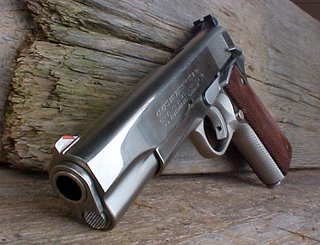 Jim Clark was a founding member and the first President of the American Pistolsmiths Guild. As a competitor, perhaps he was proudest of being the only civilian trained national bullseye champion. In 1950, Jim Clark founded Clark Custom, and began a career of producing no bullshit innovative and competitive pistols based on the 1911. One must remember that surplus GI pistols were the raw materials of building a race gun then. There were few parts on the market to augment a gunsmith's ability. If a man could not weld, fabricate and create, he could forget being a gunsmith. In this environment, Jim Clark flourished, laying the groundwork and ideas for the many permutations of the 1911 pistol that were to follow. His son, Jim Clark Jr. continues his father's legacy at Clark Custom, but as a North Louisiana resident, I always hoped to find a gun made by Jim Clark the Elder. Even in the piney woods of North Louisiana they are precious heirlooms, as rare as turtle teeth, or priced like golden boudin when they appear.
Jim Clark was a founding member and the first President of the American Pistolsmiths Guild. As a competitor, perhaps he was proudest of being the only civilian trained national bullseye champion. In 1950, Jim Clark founded Clark Custom, and began a career of producing no bullshit innovative and competitive pistols based on the 1911. One must remember that surplus GI pistols were the raw materials of building a race gun then. There were few parts on the market to augment a gunsmith's ability. If a man could not weld, fabricate and create, he could forget being a gunsmith. In this environment, Jim Clark flourished, laying the groundwork and ideas for the many permutations of the 1911 pistol that were to follow. His son, Jim Clark Jr. continues his father's legacy at Clark Custom, but as a North Louisiana resident, I always hoped to find a gun made by Jim Clark the Elder. Even in the piney woods of North Louisiana they are precious heirlooms, as rare as turtle teeth, or priced like golden boudin when they appear. Finally, after years of perseverance, fortune would shine on me, and I found a Jim Clark the Elder gun that I could afford.
 This pistol was ordered from Jim Clark by an anesthesiologist in 1981. It is built on a Colt Mark IV Series 70 base gun. He shot a "box or two" of ammunition through it and put it away. Even though this pistol does have a Safari Arms extended safety and slide stop, they were impeccably fitted by the old man himself. The lockwork on this pistol snicks back and forth with a precision and an ease that belies it's close tolerances.
This pistol was ordered from Jim Clark by an anesthesiologist in 1981. It is built on a Colt Mark IV Series 70 base gun. He shot a "box or two" of ammunition through it and put it away. Even though this pistol does have a Safari Arms extended safety and slide stop, they were impeccably fitted by the old man himself. The lockwork on this pistol snicks back and forth with a precision and an ease that belies it's close tolerances. In this gun Jim Clark was not attempting to build a beautiful gun. It is almost ironic that he inadvertently did.
 Nickel was laid across this pistol not to provide additional glitz, but to effectively prevent rust in the sweltering Louisiana heat. When Jim Clark Sr. needed a competition trigger, he simply took the original Colt trigger, drilled and tapped it for a set screw, and then adjusted the length of the stirrup by welding a polished shim at the back to achieve a zero take up, minimal over travel trigger. The pull was adjusted through polishing the trigger stirrup, adjusting the sear angle, hammer hooks and sear spring. This pistol has a trigger that breaks consistently at three pounds with no wiggling around in the trigger guard.
Nickel was laid across this pistol not to provide additional glitz, but to effectively prevent rust in the sweltering Louisiana heat. When Jim Clark Sr. needed a competition trigger, he simply took the original Colt trigger, drilled and tapped it for a set screw, and then adjusted the length of the stirrup by welding a polished shim at the back to achieve a zero take up, minimal over travel trigger. The pull was adjusted through polishing the trigger stirrup, adjusting the sear angle, hammer hooks and sear spring. This pistol has a trigger that breaks consistently at three pounds with no wiggling around in the trigger guard. To cement the gun in the shooter's hand, Clark applied his trademark "Tiger Tooth" stippling to the front strap and mainspring housing. Clark's technique is not as pretty as Ted Yost's perfect checkering, nor as fashionable as Ed Brown's reptilian scales. Clark's stippling is incredibly effective however. Grasping it is like holding a rasp in your fist. When the little metal teeth created by Clark's chisel bite into one's calloused hand, this pistol is not going to shift under recoil.
In 1981, Clark Custom offered low mounted Bomar adjustable sights, or Smith & Wesson K frame adjustable sights.
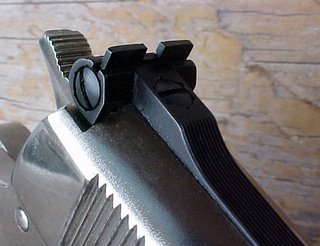 Like many early shooters, my anesthesiologist friend opted for the S&W sights. They were a known quantity with an available parts supply, and when mounted correctly, they compliment the lines of the 1911. Indeed, they almost look like the Gold Cup's Eliason sight. It is indicative of Jim Clark's craftsmanship that not a hint of the original rear sight dovetail remains to be seen through the nickel finish. Unless the hammer was placed beside an original, the bobbed hammer is just as stealthy. Clark paired the Smith & Wesson rear sight with a ramped hardball front sight, into which he grafted an orange plastic insert. The orange portion of the front sight precisely fills the rear notch. There is no more nor less than necessary.
Like many early shooters, my anesthesiologist friend opted for the S&W sights. They were a known quantity with an available parts supply, and when mounted correctly, they compliment the lines of the 1911. Indeed, they almost look like the Gold Cup's Eliason sight. It is indicative of Jim Clark's craftsmanship that not a hint of the original rear sight dovetail remains to be seen through the nickel finish. Unless the hammer was placed beside an original, the bobbed hammer is just as stealthy. Clark paired the Smith & Wesson rear sight with a ramped hardball front sight, into which he grafted an orange plastic insert. The orange portion of the front sight precisely fills the rear notch. There is no more nor less than necessary. Today, when Clark 1911s are mentioned, many people visualize the incomparable Clark Meltdown.
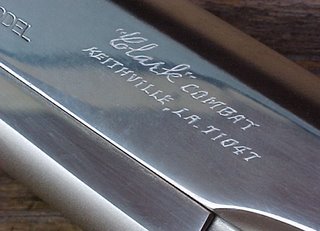 Clark Custom is not founded on the Meltdown, but rather on guns that work. Jim Clark was not known for building beautiful guns. Indeed, Armand Swenson was the man to go to for a beautiful custom Colt in those days. Jim Clark was known for building effective guns. When I purchased this pistol, the seller also supplied me with the original paperwork. This pistol received Clark's "Combat Conversion", consisting of an accuracy job, trigger job, the S&W rear sight, front strap stippling, ramp work, lowered ejection port, and mag well bevel. The seller had also requested the extended safety and slide release, stippled mainspring housing, orange sight insert, and white outlined rear sight. The 1981 base price for the pistol was $352. The Combat Conversion and extras cost $393.50, for a total of $745.50 in 1981 money.
Clark Custom is not founded on the Meltdown, but rather on guns that work. Jim Clark was not known for building beautiful guns. Indeed, Armand Swenson was the man to go to for a beautiful custom Colt in those days. Jim Clark was known for building effective guns. When I purchased this pistol, the seller also supplied me with the original paperwork. This pistol received Clark's "Combat Conversion", consisting of an accuracy job, trigger job, the S&W rear sight, front strap stippling, ramp work, lowered ejection port, and mag well bevel. The seller had also requested the extended safety and slide release, stippled mainspring housing, orange sight insert, and white outlined rear sight. The 1981 base price for the pistol was $352. The Combat Conversion and extras cost $393.50, for a total of $745.50 in 1981 money.Even today, Clark guns are commonly the homeliest gun on the line at any competition. Their effectiveness, however depends solely on the shooter.
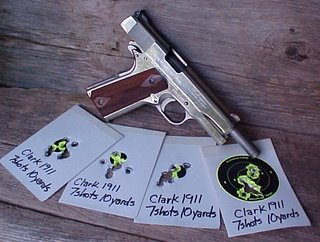 They allow no excuses. Jim Clark guaranteed a three inch ten shot group including "first shot flyers" at fifty yards. Today, other manufacturers, most notably Les Baer, make the same guarantee. They, however, manufacture their own frames and slides on CNC equipment. Jim Clark honored his guarantee on a Colt 1911 that he peened the rails on, and welded up and refitted the factory barrel on himself.
They allow no excuses. Jim Clark guaranteed a three inch ten shot group including "first shot flyers" at fifty yards. Today, other manufacturers, most notably Les Baer, make the same guarantee. They, however, manufacture their own frames and slides on CNC equipment. Jim Clark honored his guarantee on a Colt 1911 that he peened the rails on, and welded up and refitted the factory barrel on himself. When I took this pistol to the range with a couple of boxes of 230 grain hard ball, Jim Clark's work spoke for itself. This pistol shot like a hellcat. It had no stoppages and tossed the empties neatly to my right. The pistol shot every bit as well as I was able. It came to sights quickly and accurately. It placed every shot exactly where I aimed it. In 1981, Jim Clark created a pistol that continues to impress twenty five years later. That is nothing short of amazing.
More
Labels: 1911's, Clark Guns, Colt, Gun Collecting, Range Reports


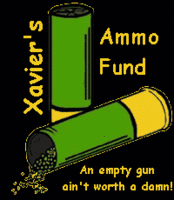





29 Comments:
Thanks for all the details. I learned something new today.
Two things:
1. That pistol is gorgeous. There's beauty in the simplicity; there's none of the present-day faddish add-ons; and, best of all, it just plain works.
2. Your write-up has to be one of the best I've ever read. Clear, concise, with pictures galore to bolster your points. Simply excellent!
What I find so absolutely perfect is that when the pistol came up for sale, fate arranged for it to come into the hands of someone who knows what it is and will appreciate it.
You are one lucky fella. Go buy a couple of lottery tickets.
You lucky b*stard!
Of course "luck" consists primarily of being prepared to take advantage of a situation.
My congratulations, sir! Helluva find.
Xavier:
Having tried the extended slide stop on the Clark 1911, how do you like it compared to a standard slide release?
As I had mentioned to you earlier, my wife liked the extended slide release on my Springfield Ultra-Compact 1911 so much that I'm going to have to put one on hers. It's simply much easier for her to push down than a standard release.
Congratulations on a wonderful acquisition. Sometimes I feel that we are simply caretakers, rather than owners, of firearms that are so beautifully crafted.
Excellent piece. You still keep the most engaging gunny blog on the web. Great article lengths & photos!
Roger.45
Beautiful gun...great article! You are in an exclusive fraternity now.
Roger
Ps. How did anonymous at 8:32 get in here. Obviously a GFW.
Awesome pistol, great story.
Thanks
Fantastic gun and post. the gun dates from the time I was considdering an aprenticeship with a 'smith (i didn't take it).
I used to marvel at the shiny custom guns with all of the extended extras, then i fell out of love with them, on the basis that John Browning knew exactly what he was doing with none snagging controls, and while it was possible to tighten up grouping and correct manufacturing tolerances with peening rails, nipping slides in a vice and building up with weld, it was often at the expense of increased sensitivity to crud.
While the belled feed ramps and polished chambers were a recipe for a KB (Glock it seems, gives these as factory standard)
I'm still not sure about weld near a chamber but still...
This gun might just have changed my mind.
thanks
Looks like Anonymous is surfing the web from his U.N. office.
Or his mom's basement.
Great blog by the way. And no, I don't have a sign-in.
Steelheart
Blackwing,
I still prefer the usual unextended slide release. I shoot with my thumb on top of the thumb safety. and as a result, it holds down the extended slide release, preventing lock back on the last shot.
I'm not going to change the way I shoot. I don't want to change out this slide stop unless I can find a nickeled stop in good condition that will fit properly. That's going to be a tall order, so I guess I will learn tolive with it.
Golden Boudain?
Heh.
Gorgeous.
Awwww .... I just drooled all down the front of my shirt.
I like the stippling on the front strap, it looks like ostrich skin.
Well written. One correction ... safety & slide stop are Safari Arms (not King).
Nice gun and great commentary.
However, I would like to see some shots/targets from 50 yards like you mention. The targets you have displayed say seven shots from 10 yards. My out of the the box colt series 80 will shoot with the same accuracy right out of the box. 50 yards is a different story however...........
Mitch, I'm certain that at 50 yards, my skill will not measure up to the gun's potential. If I had access to a Ransom rest, I'd love to bolt it in........
Check this out:
http://youtube.com/watch?v=sYWjLMt1JXY
http://www.flickr.com/photos/10786629@N05
This is my invention to convert the 1911 to allow the thumb saftey to release the slide stop. Free to use
Barry Crowe
Clark Long Heavy Slide 1911s
In the operation of my Dad's manufacturing business he had occasion to have a few dozen parts machined from time to time by a contractor. At about age 15 I would go with him to pick up the parts at a small shop next to the Jersey Gold milk factory in Shreveport. I was fascinated by the other work being done in the shop. The machinist was working on guns, 1911-A1 pistols.
The year was around 1956. The machinist was James E. Clark. Jim Clark became my mentor for pistols, shooting, reloading and, unknown to most in the shooting industry, flying. He was like a father to me. I spent many, many hours with him learning all I could about pistols, revolvers and reloading. I used to watch him prepare, fixture, preheat and weld the end cut from a military slide to a Colt 38 Super slide as the beginning of the long heavy slide .38 midrange bullseye guns. He made barrels by drilling and reaming the cut off rear end of military barrels to accept six inch barrels machined from premium Douglas barrel blanks. He used an induction heater to silver solder the Douglas barrel into the prepared lock up stub.
He had great success in providing winning guns to bullseye shooters with his five and six inch .38 Spl. wadcutter guns converted from .38 Super Colt 1911 guns. This success prompted the pistol industry manufacturers to bring out .38 Spl wadcutter bullseye guns.
Clark Custom is now in Princeton, LA. Previously Clark was in Keithville, LA. My years of learning from Jim were previous to his Keithville operation. His shop was behind his home in far West Shreveport.
I used to help him setup to perform his 10 shot 50 yard print test of these fine bullseye guns. On occasion we would print 10 shots to a 1 1/2" group at 50 yards from the Ransom rest. This was before he started using the Giles slide guide which helps machine rest printing.
Jim Clark regularly urged me to consider taking up flying and I did. In 1975, with fresh commercial pilot license, I moved to Houston to fly for an industrial distributor.
The last gun he made for me was a Colt 70 Series Commander compensated pin gun that is still in my sizable collection of 1911 guns. It's been lost, but I had the test target for years with the 10 shot 1 1/2" group from the 4 1/4" Commander.
Bob Hutchinson
Wireless Industry Association
President and Founder -1986
1911buyer@paq.net
This may not be a place for a question, but I will try.
I have a "Clark" Custom Combat Colt LWC commander made by James Clark years ago and have never fired it. It says on the slide
"Clark" Custom Combat.
Keithville, La 71047
How can I place a value on it ?
Will probably sell it as I just can't make myself shoot it. My email address
wb0qww@sbcglobal.net Thanks John
Have Clark Custom Combat and would like to find out the approx value.
Unfired and made in Keithville La.
John, your pistol is probably worth somewhere in the neighborhood of $1200-$1500 depending on features and finish. That's a WAG, the real answer depends on what an interested collector will/can pay.
Wonderful write up on Jim Clark and his creations.. I knew Jim when as a child I often visited the old original shops on Claiborne Ave, Shreveport, La.. My dad, Oscar A Hope was a friend and part time employee of Jim's in the 50s.. At the time it was a two man shop located within the city limits. I am amazed today as I think back to the days when Jim and my dad stepped outside the shop to test fire their handiwork, INSIDE the city and with impunity.. I recall lubeing freshly cast .45 wadcutters as my dad machined barrels from blank stock or ran parts through gross looking blueing tanks.. That bullet lube was thick and gooey, but I had hours of great fun in those shops..
As Jim became more well known and orders grew, he moved to larger more rural facilities. Jim and his wife Bernice were always wonderful to me through the years.. I highly treasure the friendship and memories of them.
I have a 1911 that my dad located NIB back in the 60s. Jim took pity on this poor kid and after noticing the pistol had what he called a "soft slide" he pitched it casually into a junk box and took a NEW slide from a stock pile and fitted it to my pistol. Later he installed sights, did a trigger job and did a beautiful blue job etc.. Later I had another World Class craftsman from Shreveport, E. C. Prudhomme, Master Engraver add my name to the slide of this 1911.. I now have the "touch" of two world class masters on this pistol.. It is surely my most prized firearm.
Jim Passed away in 2000, a year and a half later we purchased his home and 12 acres in Keithville. We still live in the wonderful Log Home that Jim & Bernice built..
I am also a volunteer at the Fire Dept. that Jim organized and built, but that is another story..Now I want to go watch the old 8mm films from those days at the shop and with his airplane We are constantly reminded and surrounded by Jim's memory and legacy..
I just purchased a Colt Series 80 Gold Cup that had the Clark Accurizing Job. I called Clark Custom, and they told me what went into the accurizing job. It has Clark's name on it and the original receipt. The acc job was $400.00 in 1993$$$$. The gun is very accurate. I also own a full size Nighthawk Predator, and the Gold Cup is every bit as accurate as the predator, and I LOVE my predator. The slide to frame fit is adjustable, since Clark modded the frame a bit, and the fit can be adjusted so there is no play. The barrel to frame fit is very tight, and the trigger is a beautiful 3lb. It also has a Clark Hammer, Clark Sear and Clark Sear Spring. I don't have a pic of it yet, though.
To have a gun bult by Jim Clark Sr. personaly it will not have the logo on the outside but stamped on the inside. Sr. stopped building guns personaly in 1959 when Archie Anderson, Sam Bison and John Clark came to work at CCG. Clark Jr. started part time in 1964 at age 8 and full time in 1974. Anderson retired after 51 years at Clarks
I was wondering if you use bullet lube on all your gun barrels and if that would make any difference in their performance?
I just found a clark longslide custom in 38super and a fitted 9mm barrel and bushing.The previous owner was going to have it painted with ceracote, I pleaded not to do this just because he didn't like blued guns, like changing the Mona Lisa's hair color.we worked out a deal for a new glock, could't get my wallet out fast enough,DONE DEAL
I have a colt 38 super that was converted to 38 sp by Jim Clark sr. in the 1950s. has extended front sight and bbl. was wondering what it was worth today. thanks Doug swbldsllc@gmail.com
Post a Comment
<< Home